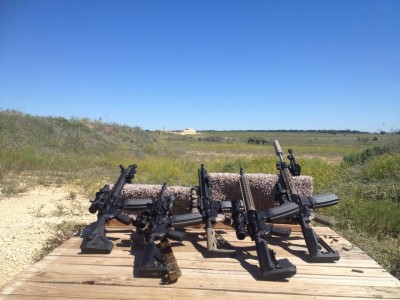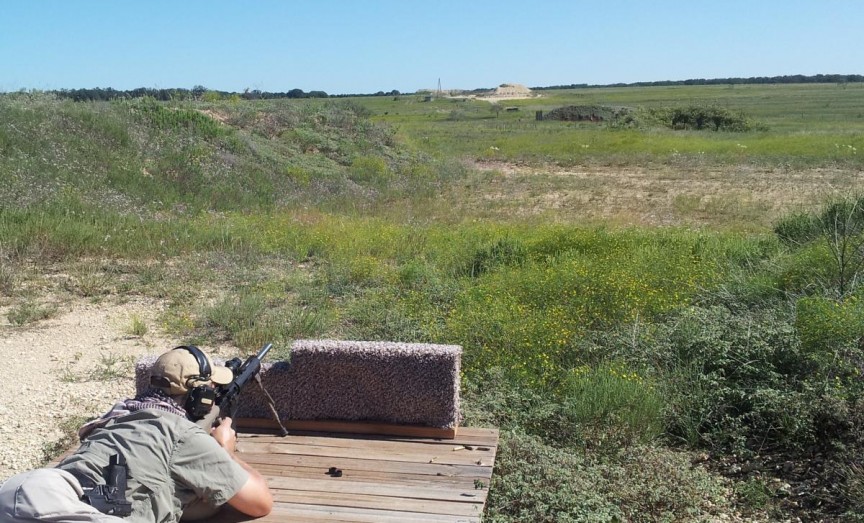“Long range” rifles and equipment generate a lot of sales for gun magazines and equipment manufacturers. But what is a “long range” shot? It depends who you ask. Many police never fire at distances beyond their department ranges of 50 or 100 yards. Few private citizens shoot much beyond that, especially in urban areas where you can only shoot at an indoor range. During a regular team training day, several of our team members placed first round hits on an 8″ plate at 500 yards. That’s the equivalent of a 500-yard head shot on a stationary target. For a skilled shooter with quality equipment, that’s unremarkable. Multigun competitions sometimes include targets up to 500 yards away. Distance shooting requires a level of mastery beyond that of your average shooter, but what does it take?
Solid basic marksmanship fundamentals and advanced marksmanship skills are required. Advanced marksmanship skills include the things you can get away with ignoring “up close and personal”, such as breath control, awareness of heart rate, stabilizing the rifle and your body, and a degree of understanding of ballistics.
The field of ballistics is where things get hairy for many shooters because it literally IS rocket science. The science of ballistics breaks down to interior, exterior, and terminal ballistics. Interior ballistics addresses what happens before the bullet leaves the bore, exterior ballistics looks at what happens to the bullet in flight, and terminal ballistics is the study of what happens to the bullet once it hits the target. Shooters focus on exterior ballistics.
Maximum point blank range is a concept that simplifies shooting. According to Wikipedia, the term point-blank range is of French origin. The center of a target was once a small white spot and the French for white is blanc. The term therefore means “aim at the white point in the center of the target”. Point-blank range is the distance a marksman can reasonably expect to fire a specific weapon hitting a specific target without further adjustment of the sights. This sight setting for maximum point-blank range is also referred to in the military as Battle Zero. Soldiers are instructed to fire at any target within this range by simply placing the sights on the center of mass of the enemy target.
Practically speaking, maximum point blank range is the distance at which you can hit a target of a given size without having to adjust your sights or aiming over your intended point of impact. The actual distance will depend on a number of factors including what kind of cartridge you are using and the target size.
For many people, long range shooting means you can no longer place the sights on the center of your target and still get hits. It can be thought of as shooting beyond maximum point blank range.

Our team members started with accurate, reliable rifles with quality optics and good ammunition. This kind of equipment will often shoot one-inch groups or better at 100 yards under controlled conditions.
The next element is to know the trajectory, or bullet path, at various distances. This comes back to external ballistics. You can do a lot of complicated mathematics to determine this, or just use ballistics software to do this for you. You can find free web-based software such as JBM Ballistics or smart phone or tablet computer apps that will do this. I’ve been using Ballistic AE, a paid app for iOS platforms such as iPhone and iPad.

Ballistics software will need to know a few basic things such as how dense the air is. This is a function of temperature, humidity, elevation, and atmospheric pressure. Some software will pull this data from GPS and Internet weather data. The primary information you will need to input is the ballistic coefficient (BC) and muzzle velocity for the load you are shooting.
The BC, which is a measurement of how aerodynamic a bullet is, is stored for many popular cartridges and bullets in many of the ballistics software programs available. The muzzle velocity is also stored for many popular factory ammunition loadings in many software packages. But velocities are based on factory tests which may or may not match your equipment. The best way to determine muzzle velocity is to measure it yourself.
Muzzle velocity of your bullet can be calculated by ballistics software based on the measured speed of your bullet through a chronograph and the distance from your muzzle to the chronograph. You will need to fire rounds through a chronograph to determine the average speed.

In my case, I was firing a legal 14.5″ AR-15 with a 1-4 power optic and the ammunition I was shooting propelled a 60 grain Hornady V-Max bullet at 2850 feet per second. The software calculation came out to a 10 minute of angle adjustment to correct for approximately 50 inches of bullet drop at that distance. Minute of angle is a term for an angular measurement that works out to roughly one inch at 100 yards, two inches at 200 yards, etc. I had over four feet of correction to hit an 8″ target.
Once you know the bullet trajectory, you need to know your target distance to determine your correction for elevation We used a laser rangefinder, which is one of the simplest, fastest, and most accurate methods for range estimation. There are other methods of range estimation based on using your reticle or crosshairs of your scope and some trigonometry or a reference chart. The problems with some of these methods that predate laser rangefinders is you lose accuracy from imprecise knowledge of true target size and the inability to resolve measurements in scopes with coarse reference marks, which could be like measuring your height with a ruler with no markings on it.
The scope I used, like many others, has adjustment turrets that allow me to correct for elevation and wind. The shooter is able to “dial in” a 10 minute holdover on the scope to correct for the bullet drop at that distance. Without this ability to adjust the scope, the shooter must hold the aiming point over the target. This is an important factor in competitions with targets at longer distances, so even 1X optics are beginning to offer these adjustable windage and elevation knobs. The novice shooter shooting within maximum point blank range can ignore these adjustment knobs once a zero is obtained just as they would any other type of scope adjustment controls.
Once windage and elevation corrections are accounted for, the shooter can take the shot with confidence. We took these shots under relatively calm wind conditions, which helped to keep matters simple. Strong and gusty winds can make this sort of shot much more difficult.
There is some work to be done to understand what it takes to make a distance shot, but when you hear your hit on a steel target after a long delay from the time of bullet flight plus the time required for the sound to travel back from the target it makes it all worth it.

